Abstract:
Background/objective
Taiwan is facing a high prevalence of physical inactivity in children and adolescents, which has led to rising obesity and morbidity levels in young people. Chinese Taipei (Taiwan) joined the Global Matrix 3.0 to share the local information on childhood physical activity and related factors with the international community. This study reports the grades for 10 indicators endorsed by the Global Matrix 3.0.
Methods
The local data for school-aged children and youth (∼5-17 year-olds) from 2010 to 2018 were used to determine the grades. The highest priority was given to the national survey data released by the government or academic institutions, followed by academic publications using nationally representative samples. Government or academic publications relying on only regional samples were excluded.
Results
The data showed very poor Overall Physical Activity and Organized Sport Participation (F and D-, respectively). The grades for Active Transportation and Sedentary Behavior were C-. Low physical activity levels and high screen time may have led to sub-optimal Physical Fitness levels (B-). The central and local governments have recognized the importance of physical activity by creating related policy and improving facilities. Therefore, School, Community and the Built Environment, and Government Strategies and Investments all received the grade of B+. Active Play and Family and Peers received INC for a lack of sufficient data.
Conclusions
Despite great effort by the governments and schools, physical activity and fitness levels are low while sedentary behavior is prevalent in Taiwanese children and youth.
If you want to find the full article, please click the link below:
